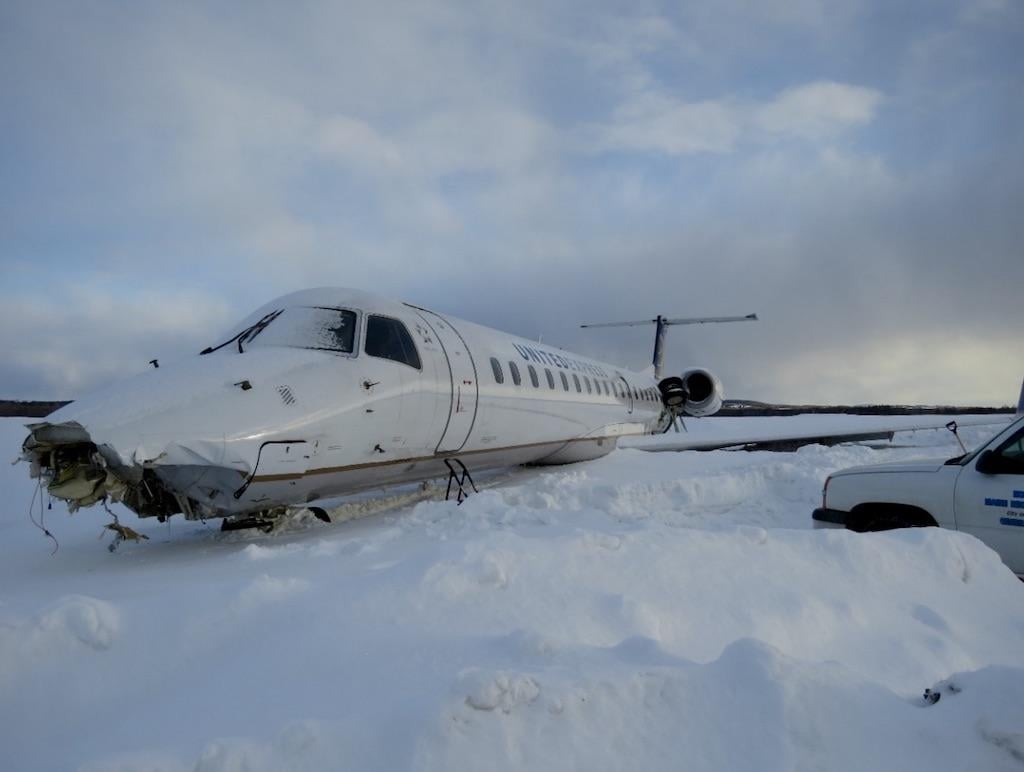
The CommutAir jet impacted a snow-covered grassy area between Runway 1 and a parallel taxiway at Presque Isle International Airport.
Anyone who’s been paying attention for the last 50 years has seen the phrase “accident chain” in company briefs or in similar writings. Basically, the concept is that an event or a procedure that normally would be routine becomes an accident or incident following a “chain” of events that went unnoticed or was not considered relevant.
Looking at the missed landing of CommutAir Flight 4933 on March 4, 2019, at Presque Isle International Airport (PQI) in Maine, I will enumerate a number of links that changed this from being a routine event to an accident.
The Embraer EMB-145XR impacted a snow-covered grassy area between Runway 1 at PQI and a parallel taxiway. Fortunately, there were no deaths in this case, but taken together, the result of the missed links was that an aircraft landed off the prepared surface of a runway.
I will examine the NTSB accident report in various places to illuminate these various links and add my two cents as the events build.
The flight crew was attempting to land on Runway 1. Snow was falling at the time. A Notice to Air Mission issued 2 hr. 19 min. before the accident indicated that the runway was covered with a quarter inch of dry snow, and the airport maintenance foreman stated that the airport had been conducting snow removal operations to maintain that condition on the runway surface.
First Link
Here lies the first link. Even as professional pilots, weather is always a consideration. The worse the weather, the greater the consideration.
The first instrument landing system (ILS) approach to Runway 1 appeared to be proceeding normally until the first officer (the pilot flying) transitioned from instrument references inside the flight deck to outside references.
During a post-accident interview, the first officer stated that he expected to see the runway at that time, but instead saw “white on white” and a structure with an antenna that was part of the runway environment but not the runway itself.
The captain (the pilot monitoring) stated that a tower was visible and called for a go-around. Both flight crewmembers were most likely seeing the automated weather observing system wind sensor pole, which was located about 325 ft. to the right of the runway centerline and about 870 ft. beyond the runway threshold. The observed damage to the lightning arrester at the top of the wind sensor pole was likely due to contact with the accident aircraft as it flew over the pole.
Second Link
Now we have got a second link. After missing an approach, a decision must be made. Do I try the approach again, or just divert to an alternate? More stress ensues.
Back to the NTSB report.
According to the cockpit voice recorder (CVR), after the go-around, the first officer asked the captain if she saw the runway lights during the approach. The captain responded that she saw the lights but that “it’s really white down there—that’s the problem.”
Airport personnel stated that snow plowing operations on the runway had finished about 10 min. before the first approach. The CVR recorded the flight crew’s discussion about turning on the pilot-controlled runway lights and sounds similar to microphone clicks before and after the discussion.
However, the PQI maintenance foreman stated that after the first approach, the runway lights were not on. Thus, the investigation could not determine, based on the available evidence, whether the flight crew had turned on the runway lights during the first approach.
Third Link
Link three happens as the pilots wonder if they had erred on the first approach.
The captain thought the jet had drifted off course when the first officer transitioned from flight instruments to the outside, so she instructed the first officer to remain on the instruments during the second approach until the decision altitude (200 ft. above ground level).
The second approach proceeded normally with no problems capturing or maintaining the localizer and glideslope. During this approach, the captain asked PQI airport maintenance personnel to ensure that the runway lighting was on, and the maintenance foreman replied that the lights were on “bright,” the high-intensity setting. Thus, the flight crew had a means to identify the runway surface even with the reported snow cover at the time.
As the jet approached the decision altitude, the captain instructed the first officer to disconnect the autopilot, which he did. About 9 sec. later, the aircraft reached the decision altitude, and the captain called, “Runway in sight—twelve o’clock.” This callout was followed by the first officer’s statement: “I’m stayin’ on the flight director ‘cause I don’t see it yet.”
A few seconds later, while the jet was below 100 ft. above ground level, the captain and the first officer expressed confusion, stating “what the [expletive]” and “I don’t know what I'm seein’,” respectively, but neither called for a go-around. The aircraft subsequently impacted the snow-covered grassy area between the runway and a parallel taxiway.
During a post-accident interview, the first officer stated that when he transitioned from flight instruments to the outside during the second approach, he again saw “white on white” as well as blowing snow and that the jet touched down before he could determine what he was seeing.
The captain had apparently intended for the first officer to focus on the flight director and not look outside for the approach lights or the runway. Company policy stated that the pilot flying should monitor the instruments until the callout “runway in sight” and then transition to outside references no later than 100 ft. above the touchdown zone elevation.
Company policy also stated that a pilot should call for a go-around if either the runway environment was not in sight by the decision altitude or the successful completion of the approach was in doubt. Thus, when the first officer looked outside after the captain’s “runway in sight” callout and did not see the runway, one or both flight crewmembers should have called for a go-around.
Further, the captain reported that, during the second ILS approach to Runway 1, she saw the tower again but explained that the jet had leveled off to clear the tower before continuing to descend. The appearance of the tower should have prompted the captain to call for a go-around, just as she did during the first approach.
The captain should have recognized that an aircraft on the proper vertical and horizontal paths of an ILS approach would not have flown that close to a 30-ft. tower while descending below the decision altitude.
We note further links to the Presque Isle accident chain in Part 2 of this article.





